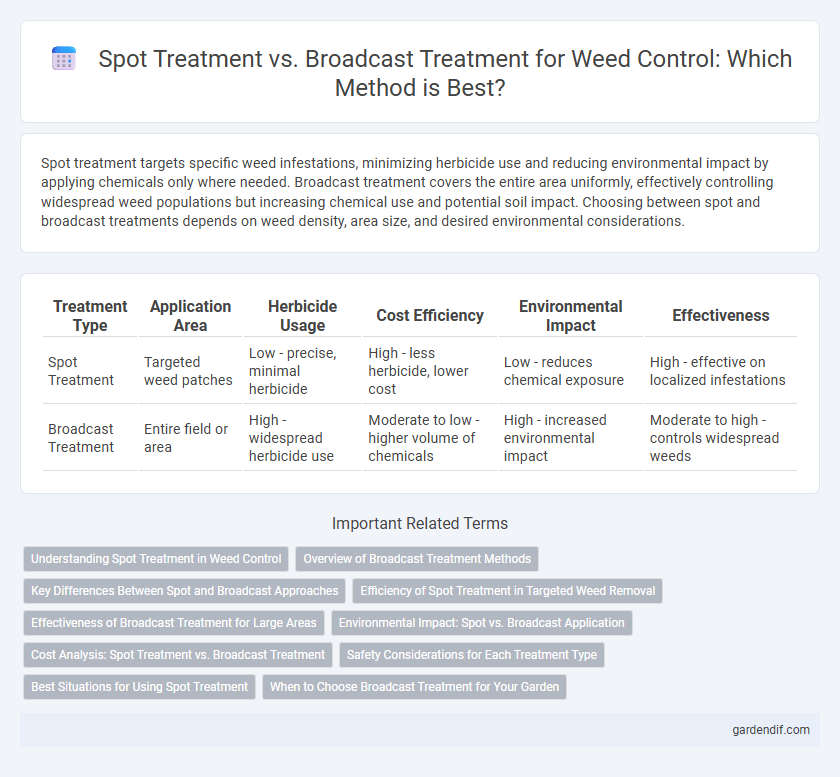
Spot treatment vs Broadcast treatment Illustration
Spot treatment targets specific weed infestations, minimizing herbicide use and reducing environmental impact by applying chemicals only where needed. Broadcast treatment covers the entire area uniformly, effectively controlling widespread weed populations but increasing chemical use and potential soil impact. Choosing between spot and broadcast treatments depends on weed density, area size, and desired environmental considerations.
Table of Comparison
| Treatment Type | Application Area | Herbicide Usage | Cost Efficiency | Environmental Impact | Effectiveness |
|---|---|---|---|---|---|
| Spot Treatment | Targeted weed patches | Low - precise, minimal herbicide | High - less herbicide, lower cost | Low - reduces chemical exposure | High - effective on localized infestations |
| Broadcast Treatment | Entire field or area | High - widespread herbicide use | Moderate to low - higher volume of chemicals | High - increased environmental impact | Moderate to high - controls widespread weeds |
Understanding Spot Treatment in Weed Control
Spot treatment in weed control targets specific patches of unwanted vegetation, minimizing herbicide use and reducing environmental impact compared to broadcast treatment, which covers entire areas indiscriminately. This method enhances precision in weed management by applying chemicals directly to affected spots, preserving desirable plants and lowering costs. Effective spot treatment requires accurate identification of weed species and careful application to maximize control efficacy while limiting chemical exposure.
Overview of Broadcast Treatment Methods
Broadcast treatment methods distribute herbicides evenly across the entire field, targeting widespread weed populations to ensure uniform control. Techniques include ground spraying with boom sprayers, aerial application using drones or planes, and granular spreaders that deposit herbicides directly onto the soil surface. This approach reduces the risk of untreated weed patches and is effective for managing large-scale infestations in crops like corn, soybeans, and wheat.
Key Differences Between Spot and Broadcast Approaches
Spot treatment targets specific weed infestations with localized herbicide application, minimizing chemical use and environmental impact, ideal for small or isolated patches. Broadcast treatment applies herbicides uniformly across an entire area, providing comprehensive coverage but increasing chemical volume and potential non-target effects. Key differences include application precision, cost-efficiency, and environmental risk, with spot treatment favoring targeted control and broadcast treatment suitable for widespread weed populations.
Efficiency of Spot Treatment in Targeted Weed Removal
Spot treatment maximizes efficiency by applying herbicides directly to targeted weed infestations, minimizing chemical use and environmental impact compared to broadcast treatment. This precision approach reduces collateral damage to desirable plants and lowers overall treatment costs. Data shows spot treatment can achieve up to 90% weed control effectiveness in localized areas, enhancing sustainable weed management practices.
Effectiveness of Broadcast Treatment for Large Areas
Broadcast treatment maximizes weed control efficiency over large agricultural areas by evenly distributing herbicides, ensuring comprehensive coverage and reducing weed resistance. This method enhances crop health and yield by targeting diverse weed species simultaneously, unlike spot treatments limited to isolated patches. Advanced application technologies further optimize broadcast treatments, minimizing chemical use while maintaining effective weed suppression on a broad scale.
Environmental Impact: Spot vs. Broadcast Application
Spot treatment minimizes herbicide use by targeting specific weed patches, reducing chemical runoff and soil contamination compared to broadcast application that covers entire fields indiscriminately. Broadcast treatment increases the risk of non-target plant damage and potential harm to surrounding ecosystems due to higher herbicide volumes and drift. Selecting spot application supports sustainable land management by preserving biodiversity and limiting environmental degradation.
Cost Analysis: Spot Treatment vs. Broadcast Treatment
Spot treatment targets weeds precisely, minimizing herbicide usage and reducing overall chemical costs compared to broadcast treatment, which applies herbicides over the entire area regardless of weed presence. Broadcast treatment often results in higher expenses due to increased herbicide volume and labor but provides comprehensive coverage that can prevent weed spread. Cost analysis reveals spot treatment is more economical for localized weed infestations, while broadcast treatment may be justified for extensive or uniform weed populations despite higher upfront costs.
Safety Considerations for Each Treatment Type
Spot treatment targets specific weed patches, minimizing herbicide exposure to non-target plants and reducing environmental impact, making it safer for nearby desirable vegetation and beneficial insects. Broadcast treatment disperses herbicide over a larger area, which increases the risk of drift, runoff, and potential harm to non-target species, requiring careful calibration and protective measures. Safety measures such as using precision application equipment, wearing protective gear, and following label instructions are crucial for both methods to prevent health hazards and ecological damage.
Best Situations for Using Spot Treatment
Spot treatment is best suited for managing isolated weed patches without affecting surrounding vegetation, making it ideal for gardens, lawns, and small agricultural plots where precision is crucial. This method reduces chemical usage by targeting only the visible weeds, promoting environmental sustainability and minimizing herbicide resistance. Spot treatment is particularly effective for early-stage infestations and hard-to-reach areas, ensuring efficient weed control with minimal disruption.
When to Choose Broadcast Treatment for Your Garden
Broadcast treatment is ideal for gardens with widespread weed infestations requiring uniform herbicide application, ensuring comprehensive coverage and effective control. Choose this method when dealing with large areas where spot treatment would be inefficient or time-consuming. It is particularly effective for pre-emergent weed control in lawns and ornamental beds, preventing weed seeds from germinating across the entire treated zone.
Spot treatment vs Broadcast treatment Infographic

 gardendif.com
gardendif.com